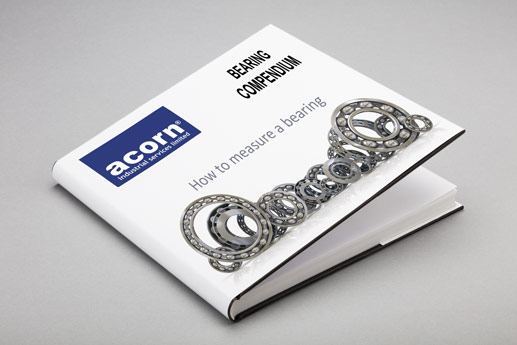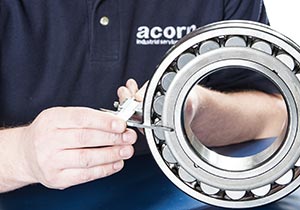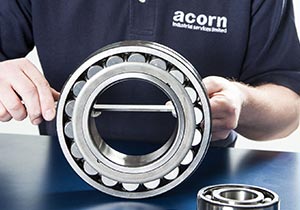The ACORN Bearing Compendium: How to measure a bearing, Part 4

If you need to source a replacement bearing, you may be wondering how to measure a bearing.
Often, bearings are measured in the event of a bearing failure, meaning that there is a rush to identify the bearing type and size so that a replacement can be ordered. This can lead to mistakes being made and further downtime and costs being incurred.
Measuring a bearing doesn’t need to be complex. We’ve put together the ultimate guide to measuring a bearing, to give you the confidence that you need to accurately measure and identify your bearings.
Read on to learn how to measure a bearing quickly and accurately.
When should you measure a bearing?
 The most common time that you’ll need to measure a bearing is after a bearing failure. When your bearing fails, you’ll need to quickly establish the size and type of bearing before you can order its replacement.
The most common time that you’ll need to measure a bearing is after a bearing failure. When your bearing fails, you’ll need to quickly establish the size and type of bearing before you can order its replacement.
Whilst most bearings have their reference numbers laser stamped or engraved into them, these numbers often rub off over time. If you’re unable to read the reference number on the side of your bearing, you’ll need to measure the bearing to determine its size.
Once you’ve established the type and size of bearing, you can choose to order a like-for-like replacement, or to upgrade your bearings to potentially extend their service life.
What measurements do you need to replace a bearing?
To source a replacement bearing, you’ll need to take three different measurements. These measurements include:
- The inner diameter
- The outer diameter
- The width diameter
Providing you also know what type of bearing you have, for example an SKF deep groove ball bearing or an NSK needle bearing, you’ll be able to order a like-for-like replacement using these measurements.
How to measure bearing size
To measure the size of your bearing, you’ll need a vernier calliper. This is the most accurate way to measure a bearing.
If you don’t have a vernier calliper available, it is possible to measure your bearing with a good quality steel ruler, but it’s a good idea to check your measurements a couple times to ensure that they are accurate.
Read on to discover how to measure each part of your bearing.
How to measure the inner diameter of a bearing
The inner diameter (ID) of a bearing is also known as the bore diameter. This is the measurement of the diameter inside the bearing. To find the inner diameter of a bearing, you need to measure from one side of the inner ring to the other.
To measure the inner diameter of a bearing, insert the outer anvils of your vernier caliper into the bore and open the caliper until it meets the inner bore of the bearing. Now, you can read the value on the caliper to find the inner diameter measurement.
If you don’t have a vernier caliper, use a high-quality steel ruler to carefully measure the inner diameter of the bearing. Repeat this three times to ensure that the measurement is accurate.
How to measure the outer diameter of a bearing
 The outer diameter (OD) of a bearing is the measurement of the total diameter of the bearing. To find the outer diameter of a bearing, you’ll need to measure from one side of the outer ring to the other.
The outer diameter (OD) of a bearing is the measurement of the total diameter of the bearing. To find the outer diameter of a bearing, you’ll need to measure from one side of the outer ring to the other.
To measure the outer diameter of a bearing, place the jaws of your vernier caliper around the outside of the bearing and close it until it meets the outer edge of the bearing. It should be a snug fit, but not tight. Now, you can read the value on the caliper to find the outer diameter measurement.
Like with the inner diameter, if you don’t have a vernier caliper, you can use a high-quality steel ruler to carefully measure the outer diameter of the bearing. You should repeat this three times to ensure that the measurement is accurate.
How to measure the width of a bearing
The bearing width refers to the width of the outer ring. This can be measured in the same way as the outer diameter. Simply place the jaws of your vernier caliper around the width of the outer ring of the bearing and close it until it meets the ring. Again, it should feel snug but not tight. The value which is displayed on the caliper is the width of the bearing.
Should you measure a bearing in inches or millimetres?
Whether you measure your bearing in inches or millimetres will depend on whether your bearing is imperial or metric. Imperial bearings are measured in inches whilst metric bearings are measured in millimetres.
One way to determine whether you have an imperial or metric bearing is to measure it. Most bearing sizes will be a full mm or inch measurement. So, if your bearing is metric, the measurement will be a full mm, for example 9mm. If your measurement is 9.5mm, it’s likely to be a 3/8 inch imperial bearing.
Choosing the right bearing for your application
Once you know what size bearing you need, you now need to establish which type and brand of bearing is best for your application. You might choose to do a like-for-like replacement, switching your bearing out for an exact replacement. However, we’d always recommend using bearing replacement as an opportunity to see if there is a bearing which is better suited to your application.
Not only will using the optimum bearing improve the running characteristics of your application, but it can also improve your energy efficiency and help to prevent premature
